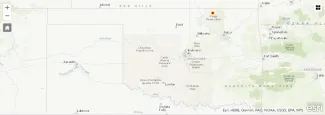A new Oklahoma citizen science program has launched, with the aim of finding new populations of the rare prairie mole cricket.
What is a prairie mole cricket?

The prairie mole cricket is a rare species thought to exist only in Oklahoma, Kansas, Missouri, and Arkansas. They are the largest species of cricket in North America and can measure over two inches in length! These insects have claw-like forelimbs that allow them to dig in the soil. Males create chambers at the soil surface that greatly amplify the sound of their calls. Between mid-March and mid-May male prairie mole crickets produce a mating call at dusk to attract flying females.
This species is found in tallgrass and mixed-grass prairie ecosystems that historically extended across 12 states. Tallgrass prairies are considered endangered since they have been reduced in area by 85-98% over the past few hundred years. In part due to this habitat loss, the Oklahoma Department of Wildlife Conservation lists the prairie mole cricket as a Tier I species of greatest conservation need.
Where are they found in Oklahoma?

Since prairie mole crickets are only heard during a short time in the spring, call from underground, and are often surrounded by tall vegetation, they can be hard to find! That is why little is currently known about where in Oklahoma these mysterious creatures live.
A citizen science program, called the Lost Cricket Project, is currently recruiting participants to help find new populations of these incredible insects! The International Union for Conservation of Nature lists the species as data deficient. By participating in “The Lost Cricket Project”, you can help collect valuable scientific data that will be used to create an updated species distribution map for Oklahoma and to help develop protocols for conducting acoustic surveys of prairie mole crickets. This information will be used to help manage this rare native Oklahoma species.

A mobile phone app that is compatible with both IOS and android phones has been created that will allow you to submit recordings of prairie mole crickets, along with their location, and habitat information.
How Can I Participate?
You can become a trained Lost Cricket Project participant in less than 10 minutes by watching the following four videos below. If you prefer, you can read along with the video by downloading a PDF script located beneath each video.
Overview of the Lost Cricket Project
Ecology
(Script of Prairie Mole Cricket Ecology)
How to Recognize the Call
(Script of Recognizing Prairie Mole Cricket Call)
How to Use the Survey App
(Script of Using the "Lost Cricket Project" App)
Download the Lost Survey App
Step 1 - Please watch all four training videos before downloading the survey app.
Step 2 - Download the Survey123 for ArcGIS app on your mobile device (available for Apple and Android).
Step 3 - Download the Lost Cricket Survey app by either:
- Clicking The Lost Cricket Project while using your mobile device, or
- By scanning this QR code with your mobile device
Where can I find the results of the study?

A map will be created that shows the locations of new populations discovered by participants. At the end of the season, a report will be published that summarizes the results of the project and acknowledges the contributions of participants. Participants can choose to have their name appear in this report, or to remain anonymous.
Acknowledgements
Thank you for your interest in the Lost Cricket Project. This project has been developed by researchers from the University of New Hampshire and the University of Tulsa with support from the Oklahoma Department of Wildlife Conservation and U.S. Fish and Wildlife Service through State Wildlife Grant F18AF00625, Prairie Biotech Research, Inc. and The Nature Conservancy.

Contact Us
If you have any questions, please feel free to contact us at the



